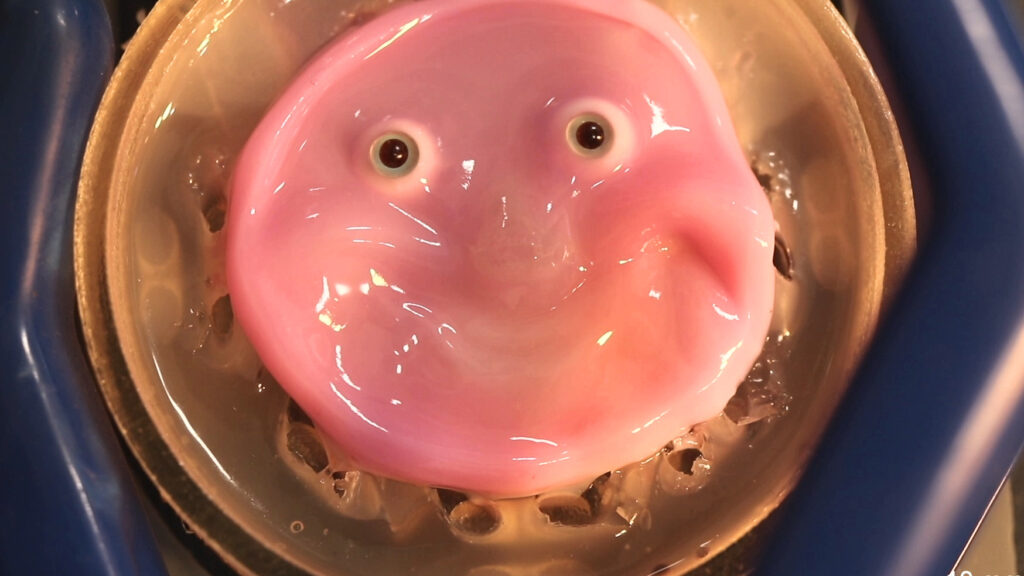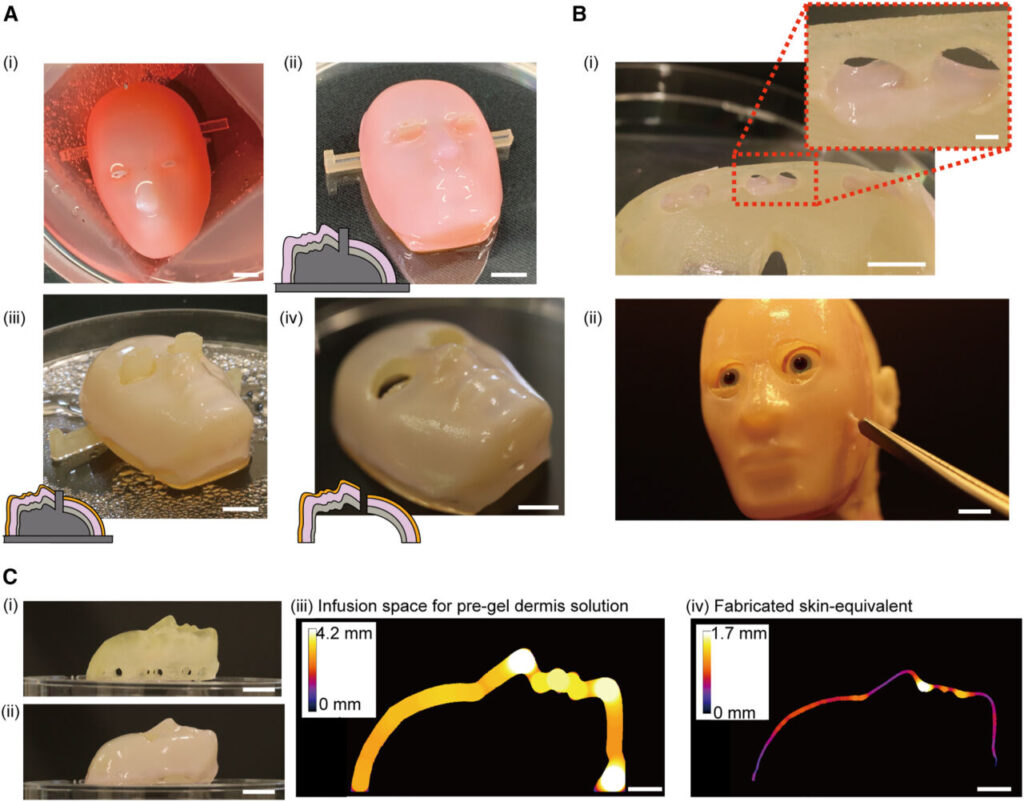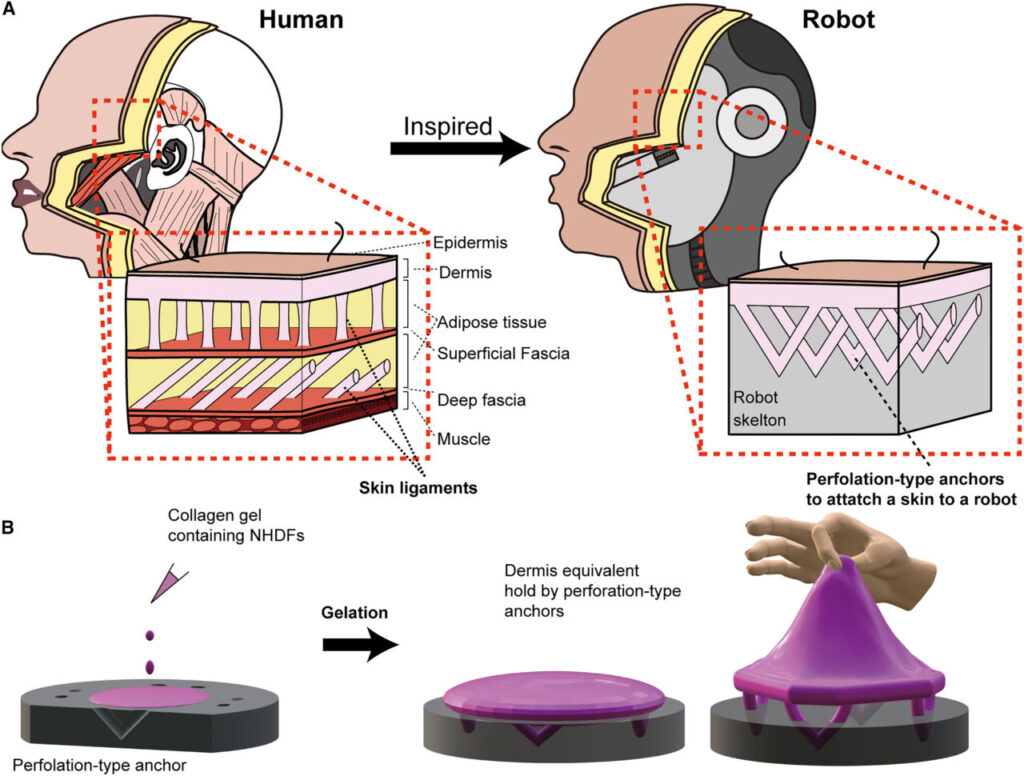
Researchers from the University of Tokyo, Harvard University, and the International Research Center for Neurointelligence have developed a method for creating realistic robotic skin using living human cells.
To demonstrate this, they built a small robotic face that can smile, entirely covered with a layer of pink living tissue.
Researchers suggest that using living skin tissue as a robot covering has advantages because it’s flexible enough to convey emotions and has the potential to repair itself.
The researchers in the study stated that as robots’ roles continue to develop, the materials used to cover social robots need to have lifelike functions, such as self-healing.
Shoji Takeuchi, Michio Kawai, Minghao Nie, and Haruka Oda conducted a study on “Perforation-type anchors inspired by skin ligament for a robotic face covered with living skin.“
The study is scheduled to be published in July in Cell Reports Physical Science. The report about this study was discovered by the Thar Tribune from a recent publication by New Scientist.
The study explains a new way to connect cultured skin to robotic surfaces using small v-shaped cavities in the robot’s structure. These “perforation-type anchors” allow living tissue to bond securely, similar to how human skin attaches to underlying tissues.
The team created a small robotic face that can make a realistic smile. The face can move because it has unique parts that flex the skin. They also put this particular skin on a 3D-printed head shape.

Takeuchi et al. created their robotic face by 3D-printing a resin base embedded with perforation-type anchors. They then applied a mixture of human skin cells in a collagen scaffold, allowing living tissue to grow into the anchors.
Real Human Skin Cells were Used for the Purpose
The researchers used living human skin cells from anonymous donors. These cells are readily available for purchase from a large number of individuals.
In their study, the researchers used commercially available human cells. They purchased Normal Human Dermal Fibroblasts (NHDFs) and Normal Human Epidermal Keratinocytes (NHEKs) from PromoCell GmbH. These cells were isolated from juvenile foreskin or different skin locations from adult donors.
A fibroblast is a particular type of cell that helps make connective tissue. Keratinocytes are the primary type of cell in the outer layer of the skin, making up about 90 per cent of the cells there. This information comes from PromoCell’s website.

The researchers obtained cells and grew them in a special liquid to create the living skin layer. They used antibiotics in the liquid to keep the skin cells alive and prevent bacteria.
The researchers used a fibroblast growth medium consisting of DMEM supplemented with 10% FBS, 1% penicillin-streptomycin, and 70 mg/mL L-ascorbic acid phosphate magnesium salt n-hydrate for the dermal fibroblasts.
The epidermal keratinocytes used a keratinocyte growth medium, the Keratinocyte Growth Medium 3 Kit, supplemented with 1% penicillin-streptomycin.
The researchers made sure to refresh the growth media for both NHDFs and NHEKs once every 2 days. This ensured the cells had the necessary nutrients to stay alive during the experiment.
Could Potentially be Useful for Testing
The researchers aim to enhance human-robot communication and advance tissue engineering. Though using actual human skin cells raises ethical questions, the researchers are focused on these goals.
They expect that their methods will be helpful in robotics and fields like reconstructive medicine and drug testing. Instead of using real human test subjects, researchers could cultivate artificial skin layers from actual human cells.
The research team believes their method for improving robotic interfaces could also be used to test cosmetics. They discovered that by repeatedly making their robot smile, they could observe the development of expression lines similar to human wrinkles.
The next important step in this research is to use this model to better understand how wrinkles form. This understanding can then be used to recreate these expressions on a chip, which could have applications in the cosmetics and orthopaedic surgery industries.

According to researchers, the technology still faces significant challenges before being used in full-scale humanoid robots. The artificial skin cannot feel things and needs to be constantly given nutrients, so it doesn’t last long when exposed to air. To fix these problems, the researchers aim to add new functions to help the skin survive longer.
Robotic skin that is continuously improved could create coverings for machines that are realistic and living. Hopefully, they will live long enough to see attack ships on fire off the shoulder of Orion. Or watch C-beams glitter in the dark near the Tannhäuser Gate. But we’re hoping those moments will not be lost in time – like tears in rain.





